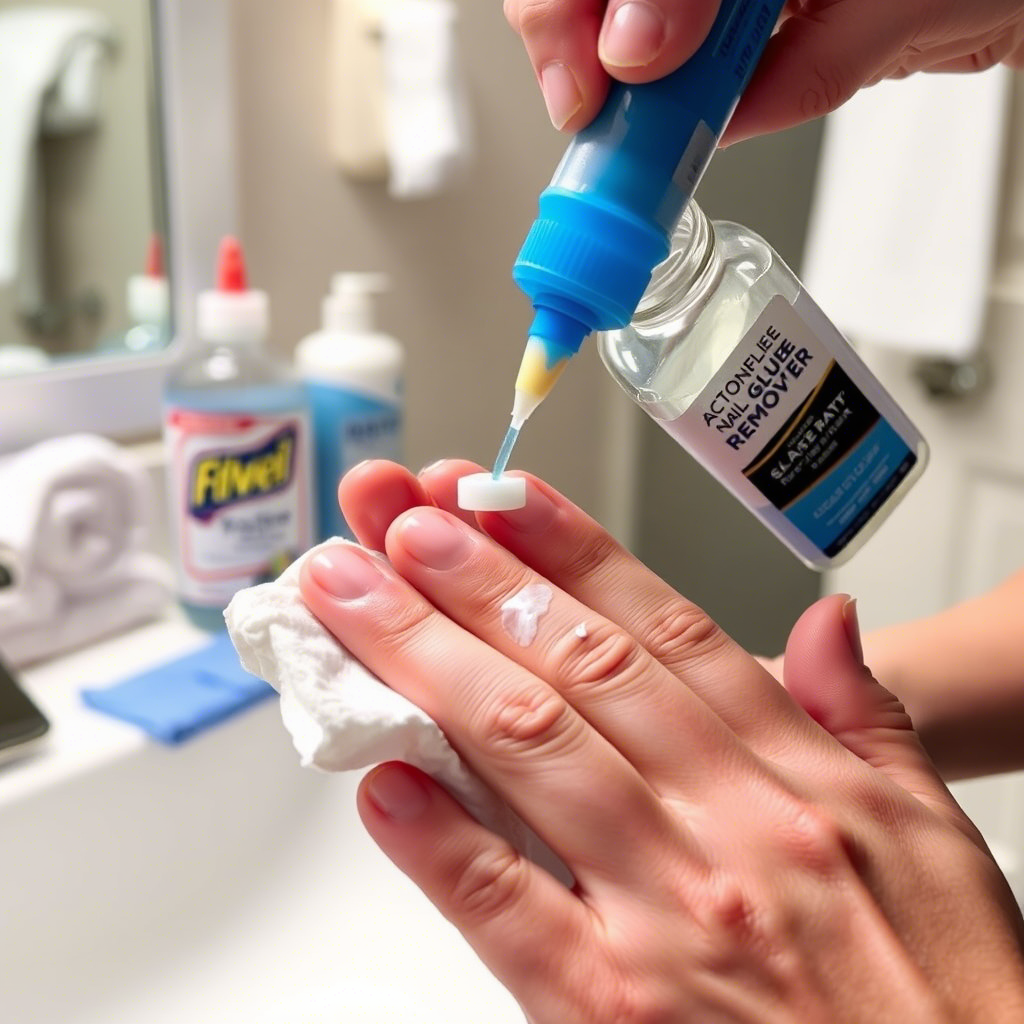Getting super glue on your fingers can be frustrating, uncomfortable, and even painful if not handled properly. Whether you’re working on a DIY project or repairing something around the house, it’s easy to accidentally get some of this powerful adhesive on your skin. But don’t worry—removing super glue from your fingers is entirely possible with the right tools and techniques.
In this comprehensive guide, we’ll walk you through step-by-step methods on how to safely and effectively remove super glue from your skin. We’ve included multiple solutions using common household items as well as specialized products, ensuring that anyone can find a method that works for them.
Why It’s Important to Remove Super Glue Promptly
Super glue (also known as cyanoacrylate) dries very quickly when exposed to moisture on your skin. While it’s generally safe for temporary contact, leaving it on for too long can cause irritation, restrict movement, or even lead to minor skin damage when trying to peel it off later. Therefore, acting quickly and using the proper removal technique is crucial.
Tools and Materials You May Need
Before we dive into the step-by-step process, here’s a quick list of materials that may help in removing super glue:
- Warm soapy water
- Acetone or nail polish remover (with acetone)
- Rubbing alcohol (isopropyl alcohol)
- Cooking oil or olive oil
- Baking soda
- Pumice stone or exfoliating scrub
- Commercial glue removers (e.g., Goo Gone, Goof Off)
- Cotton balls or swabs
- Paper towel or clean cloth
Now let’s get started with the actual steps.
Step 1: Act Fast – Rinse With Warm Soapy Water
If you catch the glue while it’s still wet or just starting to dry, your best bet is to rinse your hands under warm running water with plenty of soap. This can help loosen the glue before it fully sets.
Steps:
- Turn on the faucet and adjust the water temperature to warm.
- Apply a generous amount of liquid soap to your hands.
- Scrub your fingers gently together, focusing on the glued areas.
- Rinse thoroughly and repeat if necessary.
This method works best with fresh glue but may not remove dried residue completely.
✅ Tip: Use hand washes with moisturizing agents like aloe vera or glycerin to prevent excessive drying of the skin.
Step 2: Try Using Nail Polish Remover With Acetone
Acetone is one of the most effective solvents for breaking down super glue. If the glue has already dried, soaking a cotton ball in acetone-based nail polish remover and applying it to the affected area can dissolve the adhesive.
Steps:
- Soak a cotton ball or swab in acetone-based nail polish remover.
- Press the soaked cotton onto the glued area for 5–10 seconds.
- Slowly rub the area in a circular motion.
- Wipe away the dissolved glue with a clean cloth or paper towel.
- Wash your hands afterward to remove any chemical residue.
⚠️ Warning: Acetone can be harsh on the skin, especially if used frequently. Always follow up with moisturizer or hand cream after use.
✔️ For more details about using acetone safely, refer to Healthline’s skincare tips.
Step 3: Use Rubbing Alcohol (Isopropyl Alcohol)
If you don’t have acetone handy, rubbing alcohol (70% or higher concentration) is another viable option. It helps weaken the bond of the glue without being as drying as acetone.
Steps:
- Pour rubbing alcohol into a small bowl or directly onto a cotton pad.
- Dab or soak the glued area for several seconds.
- Gently rub until the glue begins to lift.
- Wipe off the residue and wash your hands with soap and water.
This method is gentler than acetone and suitable for those with sensitive skin.
Step 4: Apply Oil-Based Products (Olive Oil, Coconut Oil, or Baby Oil)
Oil is a great natural solvent that can break down the chemical bonds of super glue. Oils such as olive oil, coconut oil, or even baby oil work well to soften and loosen the adhesive.
Steps:
- Apply a small amount of oil directly to the glued area.
- Let it sit for a few minutes to penetrate the glue.
- Gently rub your fingers together or use a soft cloth to wipe away the glue.
- Wash your hands with soap and water to remove the oily residue.
💡 Bonus: These oils also moisturize your skin, making them ideal for frequent crafters or DIY enthusiasts.
Step 5: Use a Baking Soda Paste
Baking soda is a mild abrasive that can help lift the glue off your skin when combined with oil or water.
Option A: Baking Soda + Oil
- Mix equal parts baking soda and oil (such as olive or coconut oil) to form a paste.
- Apply the paste to the glued area and gently massage it in.
- Wipe away the mixture along with the glue.
- Wash hands with soap and warm water.
Option B: Baking Soda + Water
If you prefer a non-oily solution:
- Create a thick paste by mixing baking soda with a small amount of water.
- Rub the paste onto the glued area using circular motions.
- Rinse thoroughly and moisturize afterward.
Step 6: Try Commercial Glue Removers
For stubborn glue that won’t budge with home remedies, consider using commercial products designed specifically for this purpose. Popular options include:
- Goo Gone Original
- Goof Off Pro Strength
- 3M General Purpose Adhesive Cleaner
These products are formulated to break down strong adhesives without damaging surfaces or skin.
Steps:
- Apply the glue remover directly to the affected area.
- Allow it to sit for a few seconds as directed on the label.
- Wipe or scrub the area gently.
- Wash and dry your hands.
Always read the product instructions and test on a small area first if you have sensitive skin.
🛒 Looking for the best glue removers? Check out this curated list on Amazon.
Step 7: Use Exfoliation (Pumice Stone or Exfoliating Scrub)
If only a thin layer of dried glue remains, gentle exfoliation can help remove it over time. Use a pumice stone, sugar scrub, or loofah to wear away the top layer of glue.
Steps:
- Wet the pumice stone or apply an exfoliating scrub.
- Gently rub the glued area in circular motions.
- Rinse your hands and inspect the results.
- Repeat if necessary, then moisturize.
⚠️ Be careful not to scrub too hard, which could irritate or damage your skin.
Step 8: Wait It Out (Natural Removal)
If all else fails and the glue isn’t causing discomfort, sometimes it’s easiest to simply let it wear off naturally. Since super glue bonds only to dead skin cells, it will typically come off within a day or two as your skin sheds.
To speed things up:
- Wash your hands regularly.
- Moisturize daily.
- Avoid picking or peeling the glue, which could rip live skin underneath.
Preventative Tips: How to Avoid Getting Super Glue on Your Hands
While accidents happen, there are ways to reduce the chances of getting glue on your fingers:
- Wear gloves – Disposable latex or nitrile gloves protect your hands during application.
- Use a toothpick or applicator – Apply glue precisely without touching it directly.
- Work in a well-lit area – Better visibility reduces the risk of spills and smudges.
- Keep removal tools nearby – Have acetone, oil, or wipes ready before starting your project.
When to Seek Medical Help
While super glue is generally safe for brief skin contact, you should consult a healthcare professional if:
- The glue gets into your eyes or mouth.
- You experience severe redness, swelling, or blistering.
- You attempt to remove the glue and end up injuring your skin.
In case of eye exposure, immediately flush with water and seek emergency care.
🚨 For more information on handling adhesive-related injuries, visit WebMD’s First Aid Guide.
Video Instructions: Visual Guide to Removing Super Glue
Sometimes seeing is believing! Here’s a helpful YouTube video demonstrating different techniques to get super glue off your fingers:
YouTube Video Link: How to Remove Super Glue From Skin
Watch the full tutorial to see each method in action and determine which one suits your needs best.
Frequently Asked Questions (FAQ)
Q1: Can I use vinegar to remove super glue?
A: Yes, white vinegar can help loosen super glue. Soak a cotton ball in vinegar and apply it to the affected area for a few minutes before wiping the glue away.
Q2: Is it safe to use acetone on my skin?
A: While acetone is effective, it can be drying and irritating. Limit its use and always follow up with moisturizer.
Q3: What should I do if super glue sticks my fingers together?
A: Soak your fingers in warm soapy water or use acetone/nail polish remover. Gently work the fingers apart rather than pulling forcefully.
Q4: Does baby oil work for removing super glue?
A: Yes, baby oil can help break down the glue due to its mineral oil content. Apply generously and rub gently.
Q5: Are commercial glue removers better than homemade solutions?
A: They can be more effective for tough residues, but many homemade solutions work well for light to moderate glue contact.
Final Thoughts
Removing super glue from your fingers doesn’t have to be a stressful ordeal. By using simple household items like soap, oil, or rubbing alcohol, you can safely and effectively get rid of the sticky mess without harming your skin. Remember to act quickly, choose the method that suits your skin type, and take precautions to avoid future mishaps.
For more cleaning and DIY tips, check out other useful guides on our site, TheHowToTips.com, your go-to resource for practical, step-by-step tutorials.
📌 Share this post if you found it helpful, and leave a comment below with your favorite super glue removal hack!
Disclaimer: Always patch-test any chemical or remedy on a small area of skin before applying it widely, especially if you have sensitive skin or allergies.

